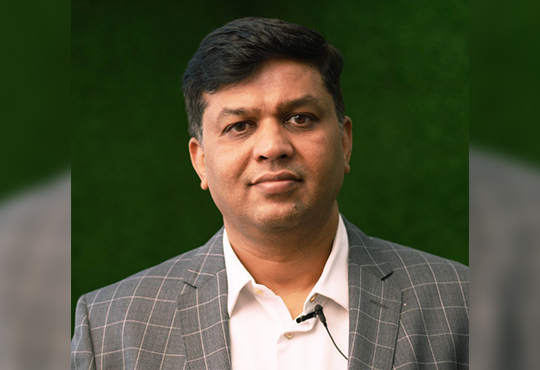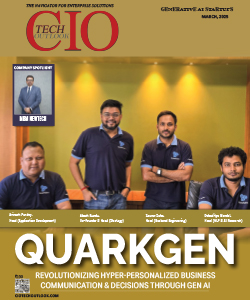Data Center Modernization: Transforming the Legacy Infrastructure
Rajesh Tapadia, COO, Nxtra by Airtel
 Rajesh is a dynamic business and operations management leader with 28 years' experience in global data center, cloud, and managed services firms. His expertise spans hyper-scale data center construction, IT service architecture, and team-based leadership. With a passion for innovation, he brings unparalleled skills in management, communication, and strategic vision to drive success.
Rajesh is a dynamic business and operations management leader with 28 years' experience in global data center, cloud, and managed services firms. His expertise spans hyper-scale data center construction, IT service architecture, and team-based leadership. With a passion for innovation, he brings unparalleled skills in management, communication, and strategic vision to drive success.Impact of Legacy Data Center Challenges on Daily Organizational Operations
Digital content will continue to rise exponentially and the last thing an enterprise would want is to be stuck with a legacy IT infrastructure that can impede their business agility and scalability. Gartner predicts that by 2025, 80% of enterprises will shut down their legacy infrastructure – those siloed, labor-intensive, slow to set up and expensive-to-maintain conglomerations of hardware and software.
Key challenges with legacy data centers
Difficulty to implement newer technologies: The legacy data centers (DCs) were built in the pre-cloud and AI era. They lack the agility and flexibility to meet the demands of modern workloads and applications like Big Data, Generative AI, IOT, Cloud computing, etc. The integration of newer IT technologies means DC infrastructure must adapt to changes and load demands so it can meet future business drivers while still keeping costs low.
Ineffective cooling - Cooling alone results in ~30 percent of the power costs for the entire data center. The cooling systems used in legacy data centers are only able to handle lower power densities and are incapable of catering to very high density AI/ML based application workloads.
Less Reliable: Legacy DCs are less reliable as they offer rated 2/3 design which is not concurrently maintainable and they only rely on a single power feed. Organisations are demanding new age data centers which can offer rated 3+ hyperscale designs and are concurrently maintainable and that can take feeds from multiple substations or have an onsite GIS substation.
Higher PUE: Another problem with legacy DCs is that their PUE (Power Usage Effectiveness) is more than 2.5. Older mechanical and electrical systems tend to deliver lower energy-efficiency than newer, more advanced systems, thus further increasing the operating costs. Below par power and cooling efficiency also results in compliance issues with environmental regulations.
Limited security measures: A legacy DC lacks both physical security as well as electronics security, along with adherence to global standards & regulations. At the physical layer, the right mix of physical and electronic security tools and components should be constantly assessed, and deployed to keep the threat vector minimal. New AI/ML based cameras, Intrusion detection systems, man traps, two-factor authentication access with secure digital key management systems are need of an hour.
With the automation and more complex IT system enabling the digital part of DC, the legacy system built on multiple hardware and software products lack the scalability and reliability to be redesigned and to accommodate new age compute, cooling and green technologies. Upgrading a legacy data center’s infrastructure is the need of the hour and can boost reliability, efficiency, flexibility and scalability while reducing operational spending.
Factors Driving Data Center Modernization and the Impact of Emerging Technologies
The technology world around us is changing at a rapid pace. Organizations are moving to digital first approach by adopting new age technologies such as cloud, AI, IoT, 5G, Big Data and AR/VR. This is leading to increased demand for new-age data centers that are agile, automated, application-friendly and multi-cloud capable.
Generative AI adoption – AI based applications are data hungry and compute-intensive. They demand Robust new age Data Centers (DCs) that are capable of handling very high density workloads going up to 50 KW per rack. When rack densities reach these extreme levels, the DCs should have the ability to handle much higher floor load bearings and innovative cooling solutions such as direct-to-chip and full Immersive liquid cooling.
Edge computing: Organizations are looking to get close to their customer to offer a hyper-personalized customer experience. The deployment of 5G networks along with rapid adoption of new age applications is driving the huge demand for Edge compute in India. These technologies require ultra-low latency and higher bandwidth to deliver its full potential. Network dense, distributed edge data centers are becoming essential to enable real-time processing closer to the source itself, thus improving consumer experience.
Agile services – Legacy manual methods of data center operations and management – in-person monitoring, maintenance, troubleshooting, and resource provisioning – do not deliver services at the speed and scale required by modern business. Organizations are now demanding automated, digitized infrastructure to achieve the agility and operational simplicity.
Energy Efficiency and Sustainability: Adoption of global best ESG practices is topping the list of strategic business priorities to stay ahead of the curve. There has also been a shift in consumer preferences towards greener and sustainable alternatives. Adopting innovative green energy solutions and replacing outdated or inefficient technology to reduce energy consumption and maintain a smaller carbon footprint to meet the sustainability targets is one of the key pillar of data center modernization.
Security and Compliance - Security in data center is utmost important and should keep pace with the technological advancements to stay ahead of evolving cyber and physical threats. To ensure data integrity and confidentiality, organizations demand modern, purpose-built DCs that can adhere to global compliance & regulations and offer new age tools to safeguard data in transit and at rest.




